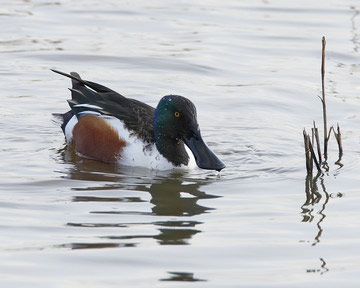
Shoveler © Richard Steel
The Atlas map shows that almost every site (40 of the 49) in the county with breeding season presence also has Shovelers in winter, but they are not the same individuals. Most British birds move out, being found anywhere from Denmark to Iberia, but mainly in western France and Spain. A bird ringed as a fledgling at Runcorn in June 1976 was shot that September in Essex, no doubt on its way to the continent. The Shovelers wintering here come from the east, most of all from Russia, and the species is found in an extra 67 tetrads which did not have birds in the breeding season (Migration Atlas).
As in the breeding season, Shovelers find most of their food on or near the water surface. They more commonly feed while swimming than other dabbling ducks, and less often upend. Groups can often be seen swimming in a line or in circles, each dabbling in the water disturbed in the wake of the one in front. Much of their diet is animal material, mainly freshwater snails, crustaceans and insect adults and larvae: Shoveler is the most carnivorous of the dabbling ducks at the Ouse Washes in Cambridgeshire (Owen et al 1986).
That Shovelers are different from other ducks is illustrated by the locations of the largest flocks in the county in winter, all on waters that tend not to hold the biggest gatherings of other species: 108 on Bar Mere (SJ54I/ SJ54J), 94 on Tabley Mere (SJ77I), 78 on Deer Park Mere, Cholmondeley (SJ55K) and 60 on Neumann’s Flash (SJ67S). Although large waterbodies tend to hold the most birds, wintering Shovelers are often to be found on small waters. In six tetrads they were on ponds, with 26 on small waterbodies compared to 65 on lakes, reservoirs and sand quarries. The map shows that they do not visit the upland reservoirs and, apart from some on the Dee saltmarsh in SJ27X, this is not a bird of the estuaries; until 2004/ 05 the Dee estuary had been included as a site of national importance for Shoveler on the basis of inclusion of birds at Inner Marsh Farm.
The shallow waters that are its preferred habitat are the first to freeze in hard weather, at which times most Shovelers fly to France or Spain. In some of the hard winters of the 1970s and 1980s, the county bird reports show that they were noticeably scarce.
The species has obviously become much more common in the last hundred years. To Coward & Oldham (1900) Shoveler was known as a winter visitor to the neighbourhood of Chester and to the Dee Marshes, but ‘in other parts of the county this duck has not often been observed’. Coward was most familiar with Shovelers as passage migrants, and summarised their status as a regular visitor on migration to the estuaries and inland waters. It was never numerous on the tidal waters but ‘occasionally a few were seen with Mallards and Pintails; as a rule it rests during the day on ponds’ (Coward 1910). In winter Coward had seen birds, in most cases singly, on the meres.
Boyd (1951) noted that the species had shown a marked increase in the last thirty years and was then seen on the meres in every month. He wrote that the largest numbers on the mid-Cheshire meres are present in winter from October to January, with from 20 to 25 at Arley and Tabley, where they often rested on the ice. Bell (1962) said that ‘outside the breeding season it is found in all months on certain meres, such as Rostherne, Tatton, Tabley, Sandbach Flashes and others’. The maximum quoted at Rostherne was about 50 between September and January, with all the other large flocks listed by Bell at the migration seasons.
Sponsored by Syngenta CTL

